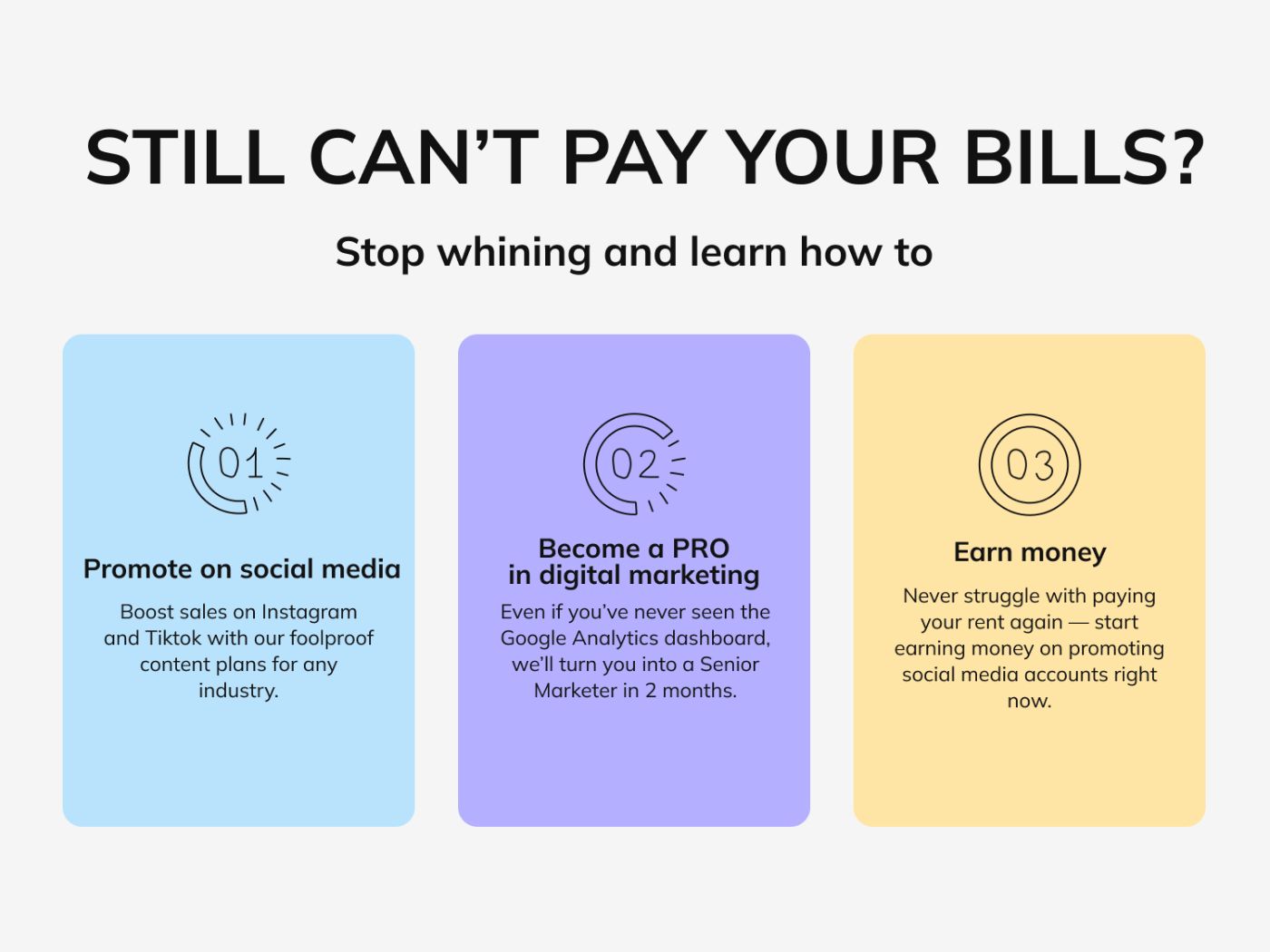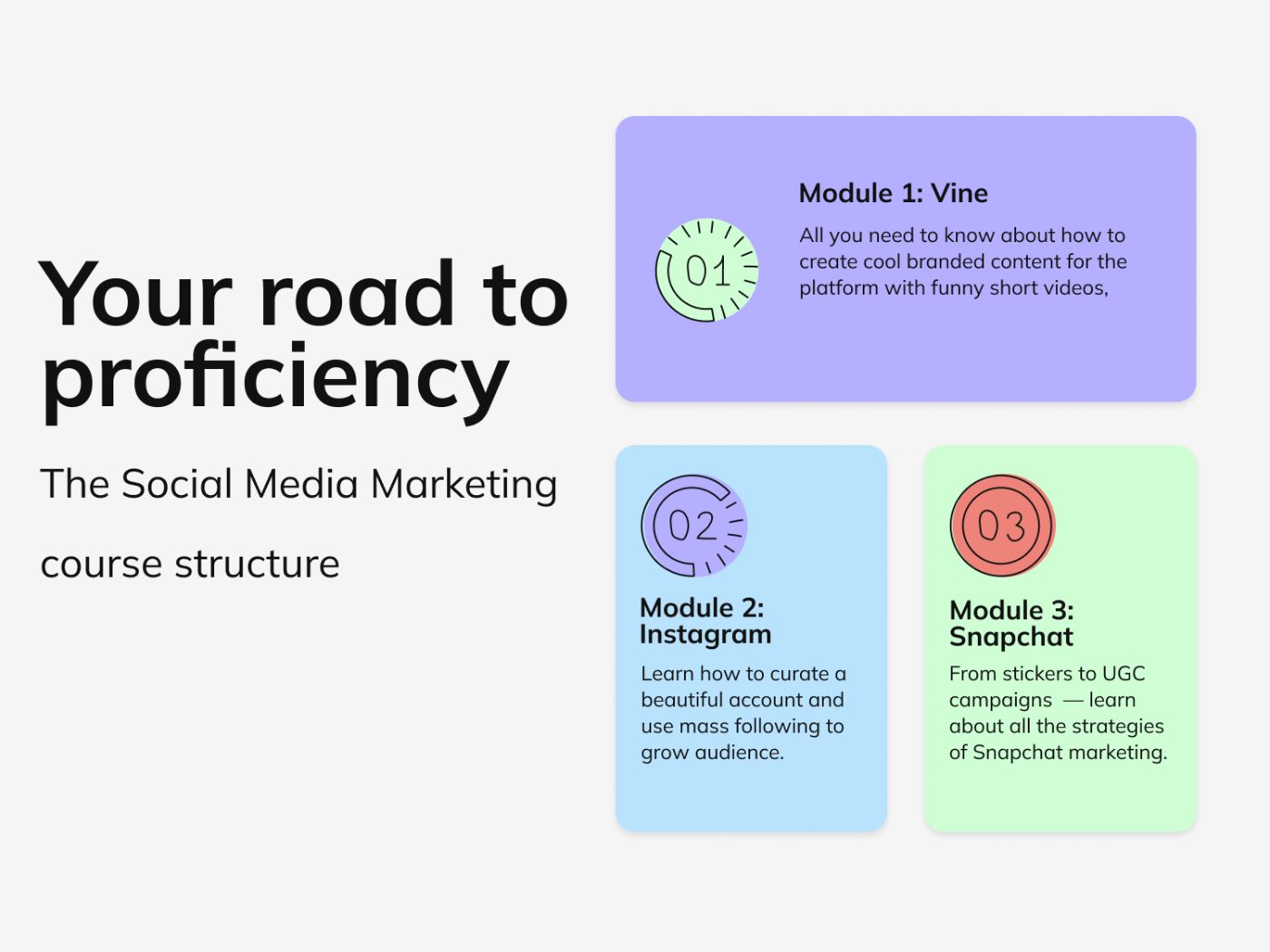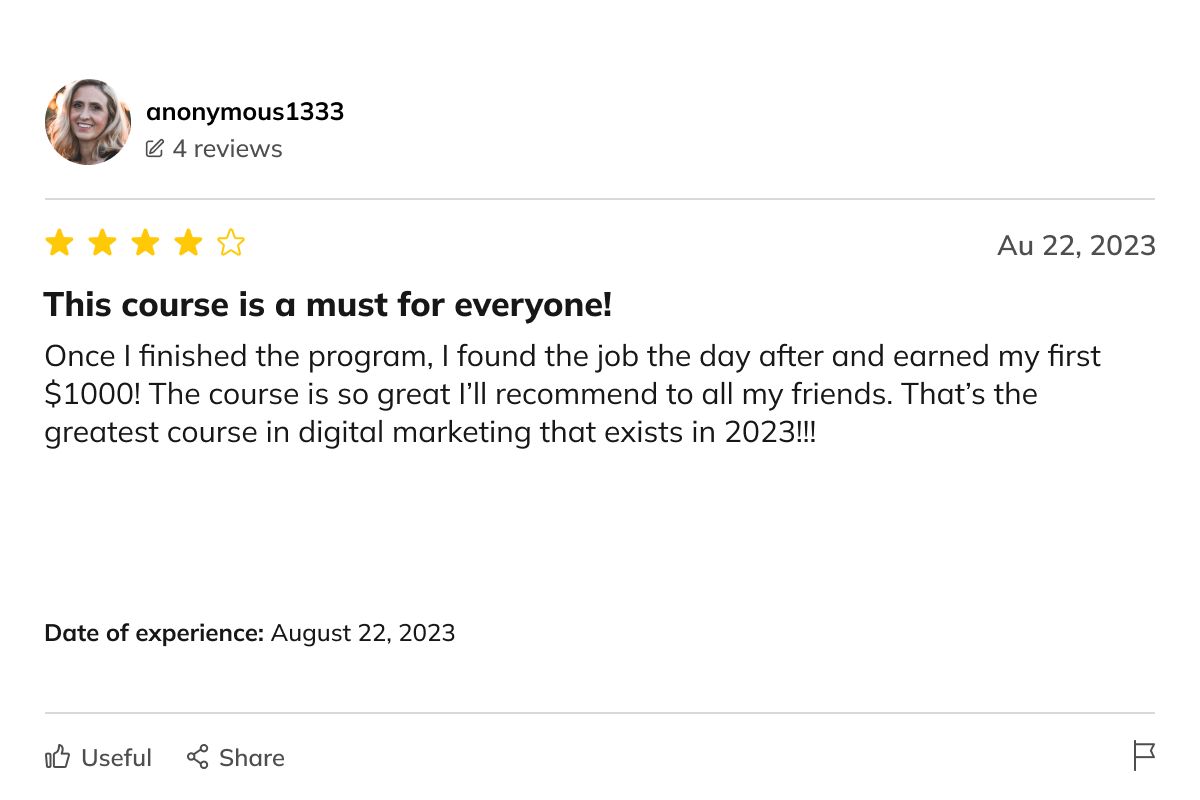and the distribution of digital products.
I Call BS: How to Choose an Actually Good Online Course
Tonya is a junior digital marketer. This year, she set a goal to get a raise but experience alone is not enough. Tonya spent the last month looking through dozens of online courses to improve her skills but still can’t decide. What if she wastes her time and money on a scam?
For all the Tonyas out there, we’ve compiled a list of red flags to look for when choosing paid online courses. Follow our hero’s story and learn how to tell if an online course is a scam.
Red Flags #1: Institutes of NowherevilleWe suggest starting the background check for an online course with the provider itself. Below, you’ll find a list of red flags for online schools and non-educational businesses.
:::warning Disclaimer: All the illustrations below are not the screenshots of real websites and the text on these images is not taken from real websites. We created them as (exaggerated at times) examples.
:::
Online SchoolsThere are many well-known platforms for online education like Coursera, Skillshare, Udemy, you get the drill. Opting for the online courses uploaded to these platforms is a relatively safe choice. But these are not the only organizations that sell online courses — and smaller, less popular online schools focused on a certain niche can be just as good.
Here’s what you need to be careful about:
The school name is copying a popular brand with a good reputation, i. e. the name of a prestigious university or an already existing online school.
If the school in question calls itself “online college”, it’s not accredited by a well-known institution. It depends on the country but if you’re considering a course produced in the US, here’s the full list of organizations that prove the legitimacy of a college.
The provider is not approved by CPD or other organizations. You can check out your course provider on the official CPD registrar, which shows a globally recognized certification for online courses. If you didn’t find your provider there, look for other accreditations, like ECICEL, ICE, or other organizations, depending on the country of operation. No accreditation doesn’t necessarily mean the course is bad, though. However, approval from one of these organizations is vital for paid, long-term “online degrees.”

Sometimes companies start their own online courses as a way to share their expertise in a niche or create a semi-passive stream of income. For example, a lot of email marketing courses were launched by ESPs like Mailchimp or Selzy.
If an online course is provided by a non-educational business, it doesn’t mean the course will try and sell you something. For example, free courses in Google Workspace tools run by Skillshop, which is part of Google, are meant for onboarding, not promotion. However, not all businesses are that honest.
Check out these red flags before enrolling:
- The company is too young. A startup that launched 6 months ago can’t provide the same expertise as a corporation that’s been dominating the market for years.
- The company’s products and services are not good. Check out the reviews and social media mentions.
- The company has no active social media accounts. The especially massive red flag is no LinkedIn account and no employees officially confirming they work there.
- The company is not legally registered. The checking method depends on the country of operation.
- There is a lot of negative news and discussion about the company. Especially if it’s not a big corporation, check out local news and mentions in subreddits and X threads dedicated to scams.
Tonya is still perplexed — she checked out the school, and it seems legit, but good schools can have bad teachers, too. And what about the courses that are not affiliated with any organizations? If you’re like Tonya, don’t worry, we’ve got you covered.

When you scroll through the landing page, pay attention to social media links and how the tutors’ professional achievements are described.
Here are the red flags to look for:
- No social media links at all, especially if there are no LinkedIn links or you can’t Google any mentions or accounts of this person.
- Vague job descriptions like “expert in [industry]” or “business owner” — which business and who said you’re an expert?
- Wacky job titles like “transformation specialist.”
- Fake company names or real names, but with no proof that the person actually works there.
Online course landing pages are designed with conversions in mind. However, how the course is described, even if it’s an advertisement, can give a hint or two — if you know where to look. Let’s dig deeper into the matter.
The Promised ResultsSince Tonya is a marketer, she knows how manipulative landing pages can be. She already threw some of the courses off the table because their promotional content looked like this:

Here are all the things wrong with this page:
- The “rags-to-riches” narrative and shaming — if a course promises a quick buck or shaming you into enrolling, it’s likely a scam.
- The “from newbie to PRO” promises — it’s especially relevant for shorter courses that last two months or less.
- The “quick first income” promises — no provider can guarantee getting a job after any course, these claims sound scammy, to say the least.
- The vague “become a Senior Marketer” promises — the clearer the result is described, the better.
The next thing to pay attention to is what providers tell you about the course itself:
No or vague descriptions of the program and structure. Both should raise suspicions. The best-case scenario is, the full program of the course, including tasks and assessments, is available.
No free demo. This implies that you don’t know what you’ll be paying for.
The outdated program. This one is especially relevant for old online courses that have existed for years. Look for outdated instruments and methods in the program description. These can include tutorials on the non-supported versions of Google Analytics, tips on how to promote your business on non-existent social media platforms, and so on.

It’s not as easy as “look for negative reviews” — they are important, but there are more red flags around:
Reviews in one source only. Check out reviews and discussions on websites like TrustRadius, Quora threads, blogs, and social media. And, if reviews in promotional content are the only thing you can find, it’s not good.
Common themes in negative reviews. If there are a lot of detailed reviews discussing the same problem, it’s a red flag.
Vague positive reviews and unverified authors. If reviews are mostly vague or over the top, like the example below, don’t trust them. For the course, having a lot of unverified reviews, especially positive ones, can be a sign that they were purchased by the course provider — or, in case of negative reviews, its competitor.

Tonya decided not to take one of the courses she was considering specifically because of this review:

“Even if there is a solid free class, there’s no guarantee that the rest of the content will be just as good, and I’m basically purchasing a pig in a poke,” Tonya is still thinking.
However, the available program description, reviews, and discussing issues with sales managers can give you a general idea of the course’s content — and whether it’s worth the money.
No practical tasks at all is a major red flag — this course won’t be that different from watching a YouTube playlist.
Here are other things to look out for:
Focus on one format. Online courses offer different types of practical tasks, such as tests, portfolio-ready projects, and simulators.
The problem is, tests, even with open-ended questions, are good for assessing your memory but not how well you understand the material — and whether you can use it for your work-related tasks. And simulators, if fully automated, are not a good choice for newbies in the niche.
\
- The lack of or the low quality of feedback. If the tutor only provides theory without progress checks and detailed and personalized feedback, it’s not worth the money. Online courses with thousands of students often use peer-to-peer feedback. However, if it’s used for complex and time-consuming tasks, a review from your groupmate won’t really help you grow.
As we mentioned, the community is one of the most valuable things about paid online courses.
Pay attention to the following:
- No designated time for questions. For example, the tutor is not in the students’ group chat, only answers emails in 2–3 business days, and so on.
- No managed community. The provider doesn’t create group chats for students and doesn’t check out on them at all — you’ll end up isolated in the learning process.
- No group tasks and projects. The absence of these is not necessarily a red flag, but if the course promises some improvement in soft skills, some kind of teamwork is a must.
\
:::tip We get it, paying for online education is a tough decision for many. So, why not start small and take a short free course?
\ We’re not hinting at anything, but Selzy’s email deliverability course can be a good start for you!
\ It’s run by a legit, award-winning deliverability expert Yanna-Torry Aspraki, and it contains all you need to know to never end up in spam again — including a 10-point anti-spam checklist.
\ And the best part is, it will only take you 23 minutes, which is a little longer than an average episode of “What We Do In The Shadows.”
\ Skyrocket your deliverability and learn the right way with Selzy!
:::
\
- Home
- About Us
- Write For Us / Submit Content
- Advertising And Affiliates
- Feeds And Syndication
- Contact Us
- Login
- Privacy
All Rights Reserved. Copyright , Central Coast Communications, Inc.